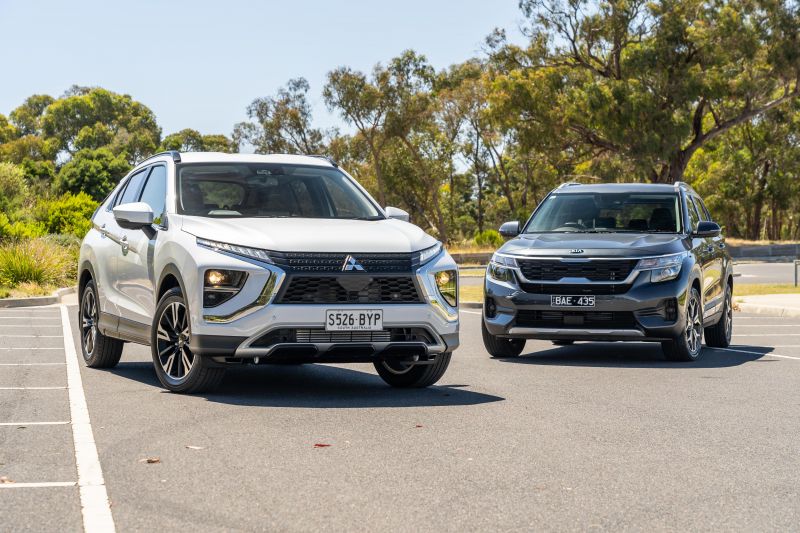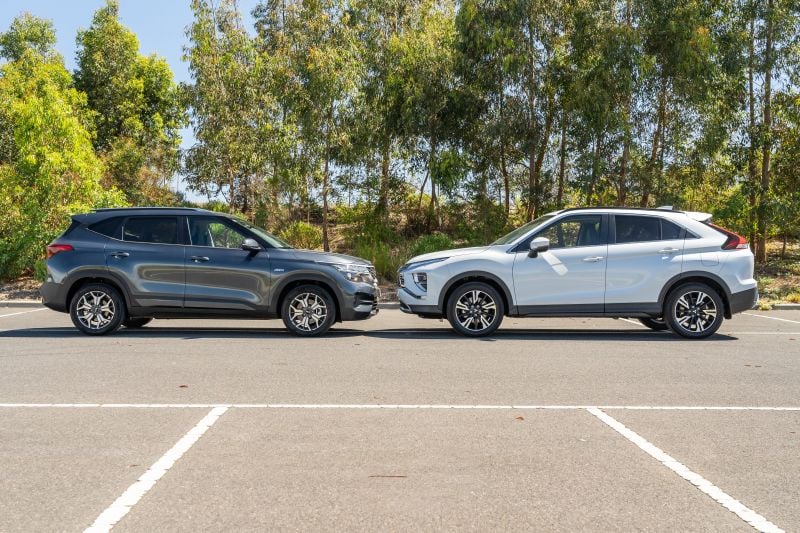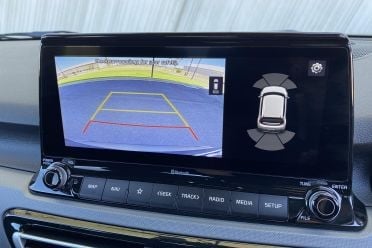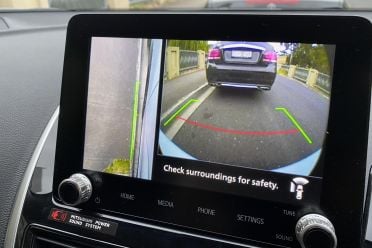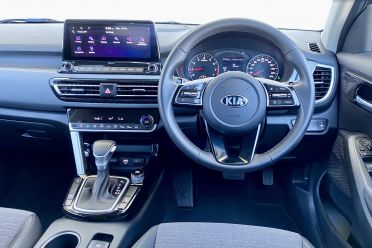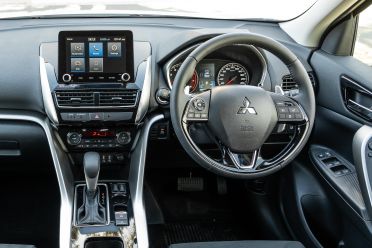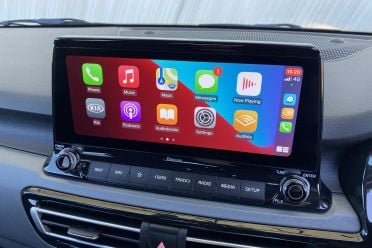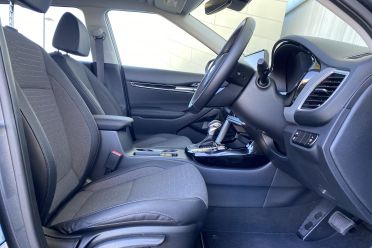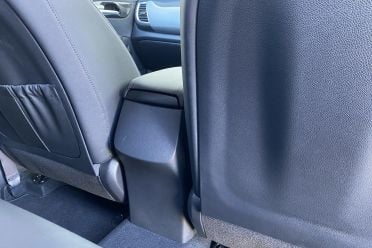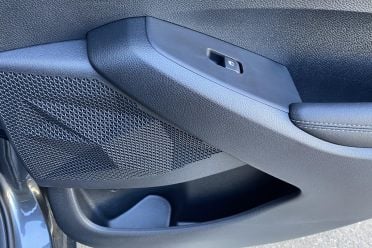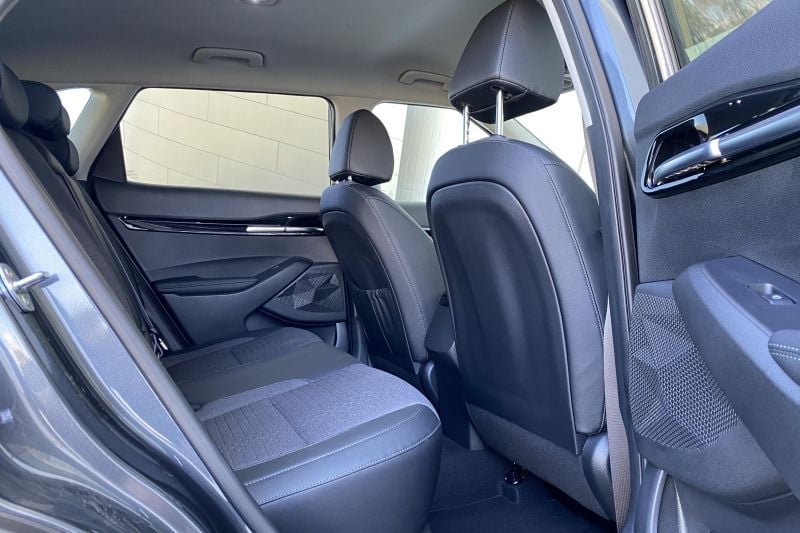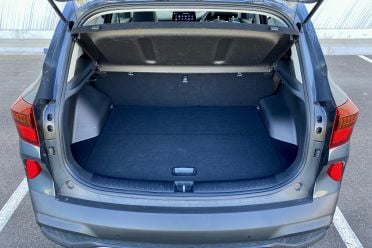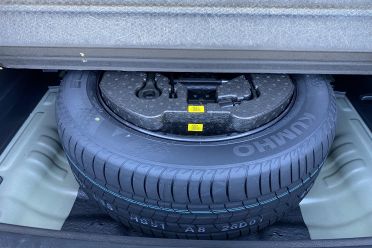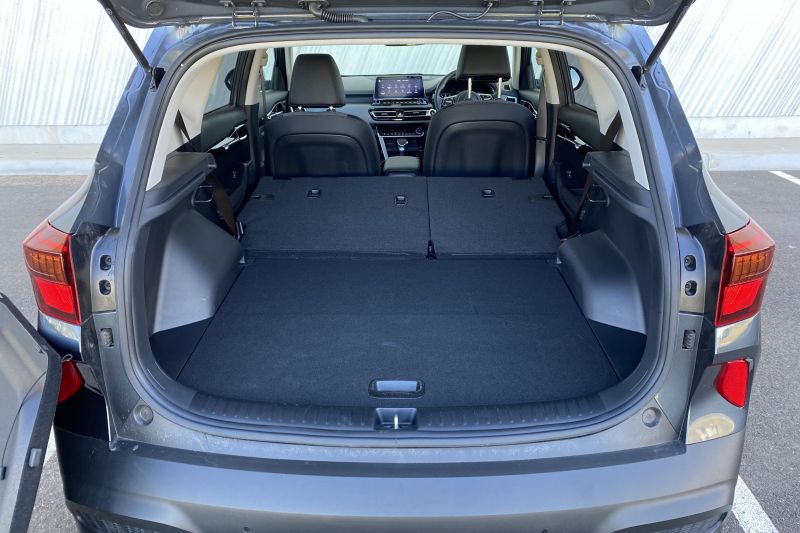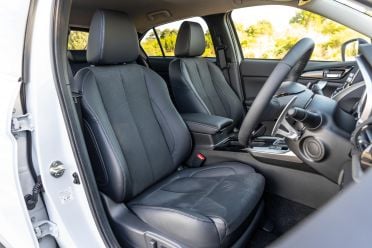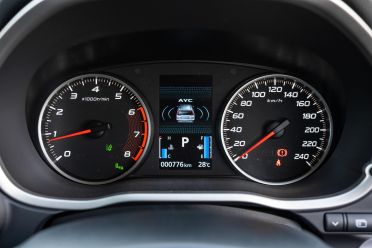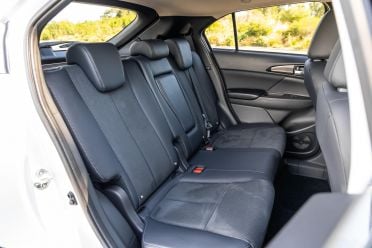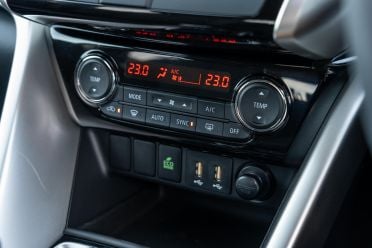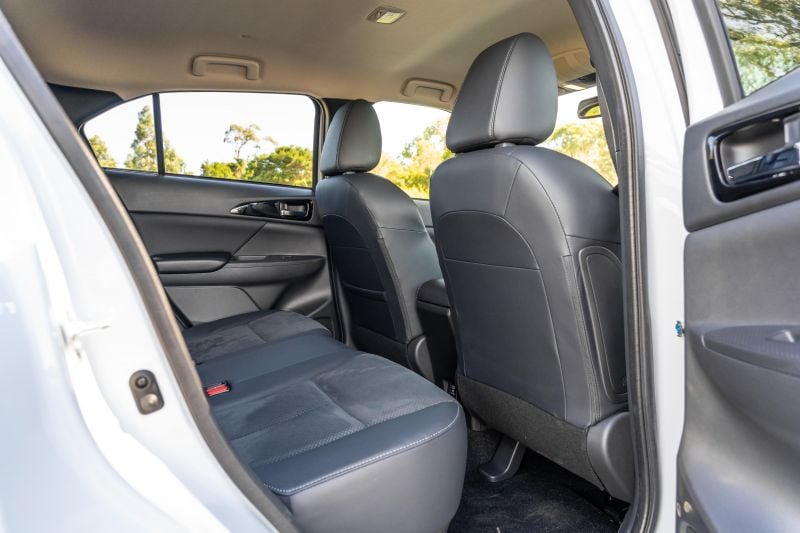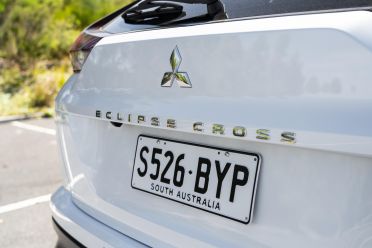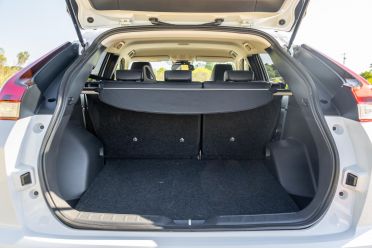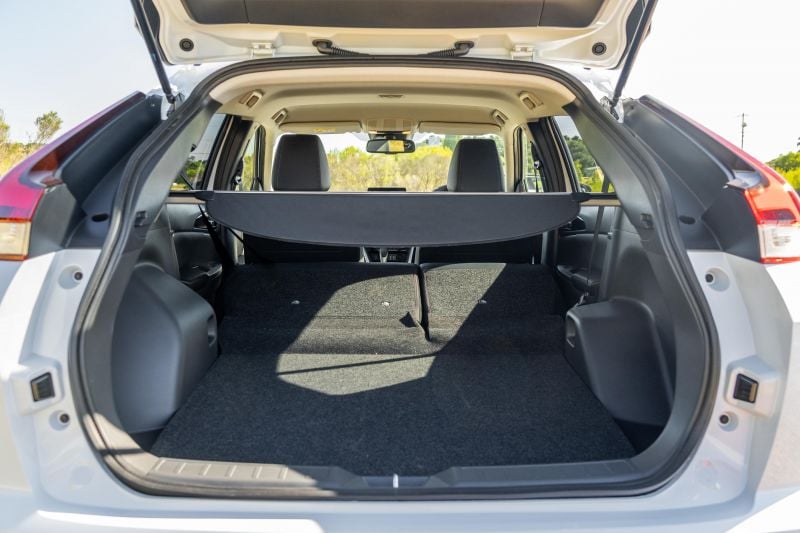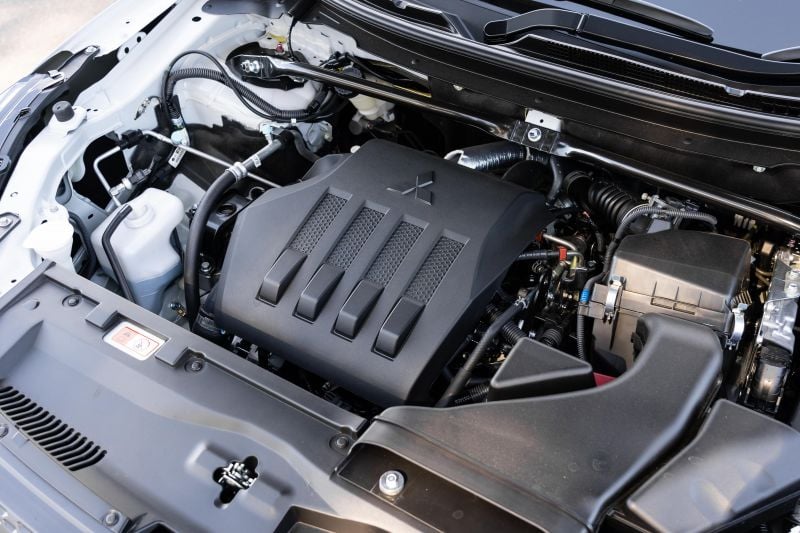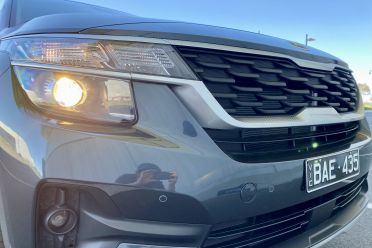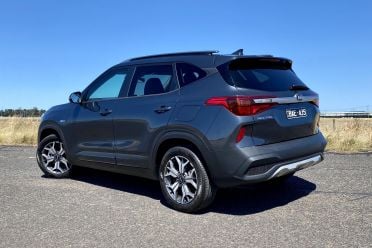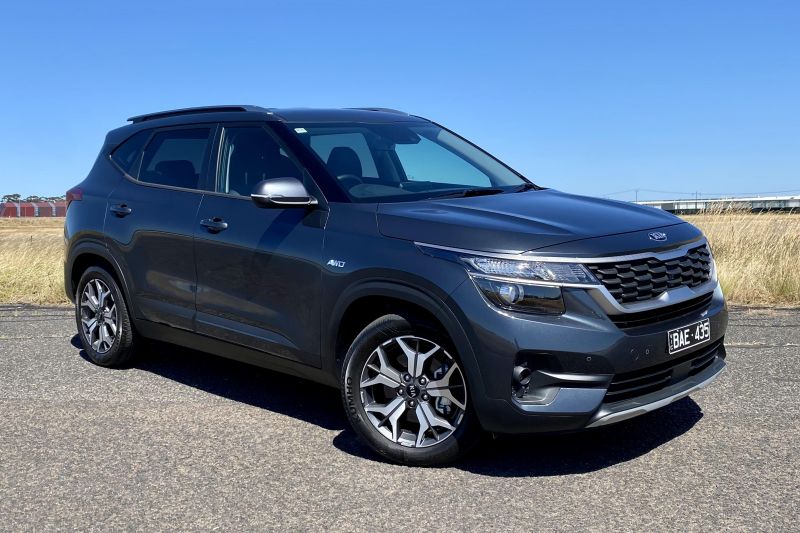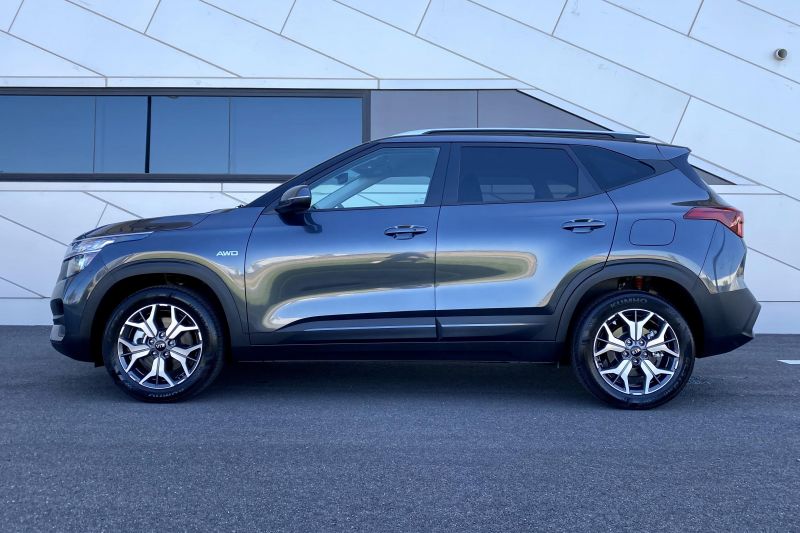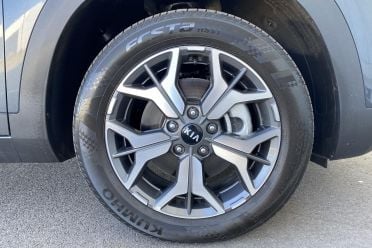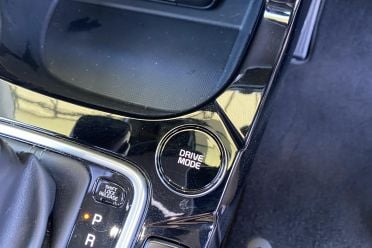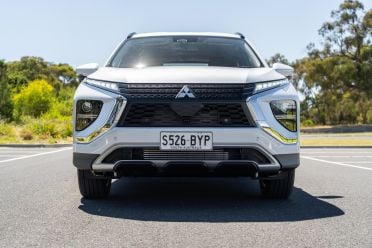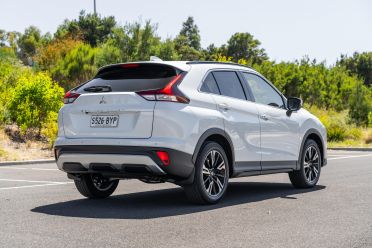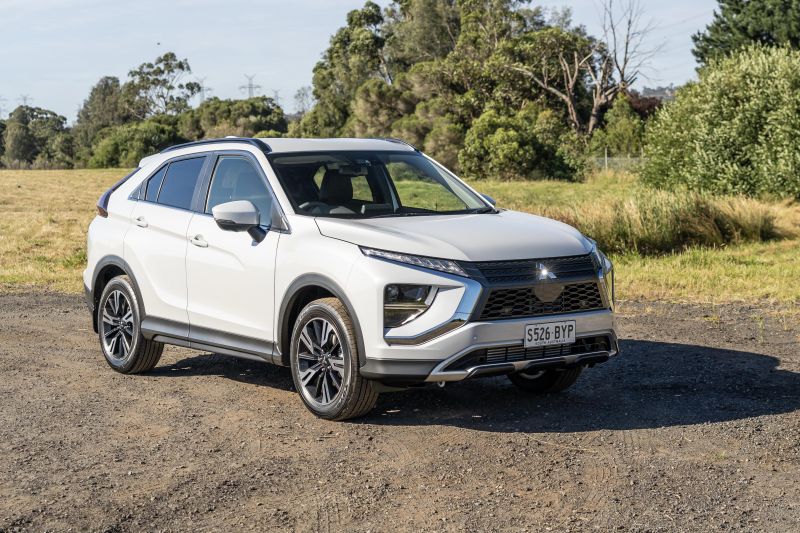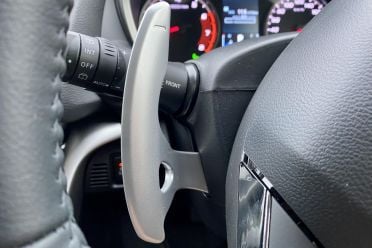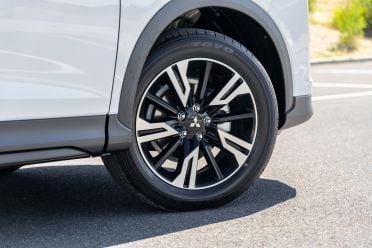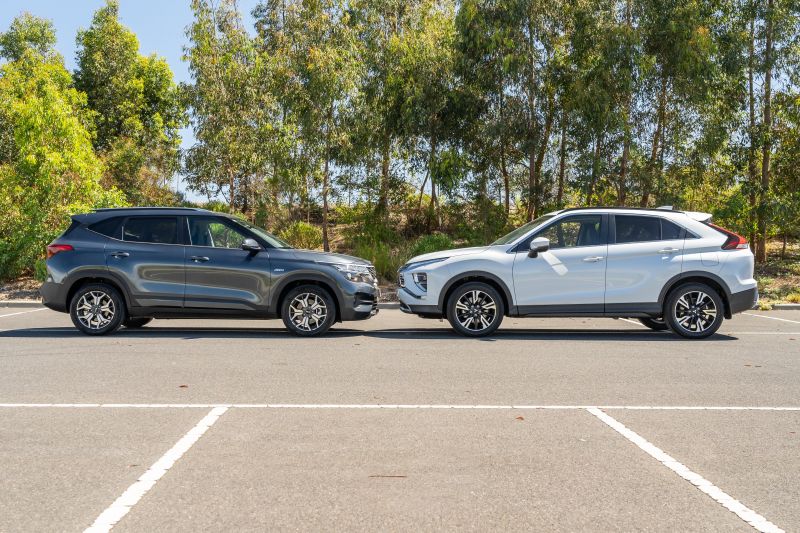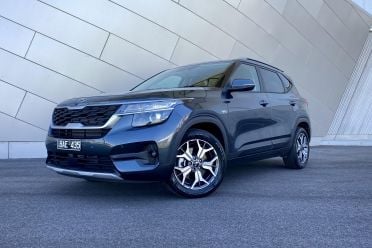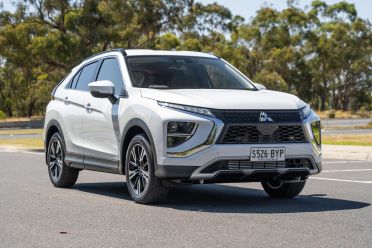Small SUV sales continue to skyrocket, drawing the attention of former hatchback buyers wanting something with a higher driving position and ‘tougher’ designs.
The Kia Seltos is one of the best in the business, and has accordingly flown up towards the top of the sales charts.
Among the laundry list of competitors is the recently updated Mitsubishi Eclipse Cross.
This younger sibling to the ASX recently had a 140mm growth spurt after its maker revised the tailgate design, meaning it now straddles the Small and Medium SUV segments.
The reason why these two stack up quite well is they’re both among the more practical offerings in their price and spec bracket – certainly compared to the likes of a Hyundai Kona or Toyota C-HR.
They’re also a little fresher and more recently updated than the Honda HR-V and Nissan Qashqai, which are likewise competing for the same audience.
How much?
This pair each sit one rung below their respective range-topping specification levels. The Mitsubishi Eclipse Cross Aspire costs $36,490 drive-away as of the time of writing, while the Kia Seltos Sport Plus is $38,290 drive-away.
Regardless of your budget, there’s probably a variation of both vehicles for you.
The Eclipse Cross range is priced between $30,490 drive-away for the base model through to $43,990 for the Exceed AWD flagship. The Seltos range kicks off at $27,790 drive-away for the S through to $43,790 for the GT-Line AWD.
What do you get?
Features common to both include alloy wheels (17-inch under the Kia, 18″ for the Mitsubishi), rather dated-looking halogen headlights with dusk sensors, proximity key access, rear-seat privacy glass, and parking sensors at both ends.
Inside each gets climate control air conditioning, Apple CarPlay and Android Auto, digital radio, two USB points, and Bluetooth phone and audio streaming.
The Kia Seltos Sport Plus has exclusive features in this pairing such as a full-size alloy spare wheel in place of a space-saver, satellite-navigation, and a larger infotainment display (10.25-inch versus 8.0-inch).
But the Mitsubishi Eclipse Cross Aspire alone among this pair has LED daytime running lights, rain-sensing wipers, a surround-view camera rather than just a rear-view, and heated front seats with electric driver-side adjustment.
Despite this pair being high-spec grades, numerous features are not available until you opt into the respective range-toppers.
For instance, the Seltos GT-Line adds LED lights, synthetic leather trim with power adjust and heating/ventilation, a sunroof, auto wipers, heated steering wheel, head-up display, rear seat vents and USB point, and a ramped-up Bose sound system.
Alternatively, the Eclipse Cross Exceed adds LED headlights, leather trim with passenger-side power adjustment, a sunroof, satellite-navigation, and head-up display. For another $3500 you can then add all-wheel drive to match the Kia.
| Kia | Mitsubishi | |
|---|---|---|
| Wheels | 17-inch alloy | 18-inch alloy |
| Spare wheel | Full-size alloy | Space-saver |
| Headlights | Halogen | Halogen |
| Daytime lights | Halogen | LED |
| Proximity key | Yes | Yes |
| Privacy glass | Yes | Yes |
| Dusk-sensing headlights | Yes | Yes |
| Auto wipers | No | Yes |
| Parking sensors | Front and rear | Front and rear |
| Parking camera | Rear-view | 360 |
| Kia | Mitsubishi | |
| Seat trim | Cloth | Microsuede |
| Driver seat | Manual | Powered, heated |
| Passenger seat | Manual | Manual, heated |
| A/C type | Climate control | Climate control |
| Touchscreen | 10.25-inch | 8.0-inch |
| Apple CarPlay | Yes | Yes |
| Android Auto | Yes | Yes |
| Sat-nav | Yes | No |
| Digital radio | Yes | Yes |
| Speakers | 6 | 8 |
| USB points | 2 | 2 |
| Bluetooth | Yes | Yes |
Are they safe?
Both come with dual front airbags, dual front-side airbags, and full-length curtain airbags. The Eclipse Cross adds a driver’s knee airbag. Both also get rear-seat top-tether and ISOFIX child-seat attachment points.
In terms of active safety tech both come with: forward autonomous emergency braking (AEB) with pedestrian detection, blind-spot monitoring/lane-change assist, lane-departure warning, rear cross-traffic alert, and active cruise control.
The Kia gets a few extras above this, namely AEB for cyclists and at junctions, and an active lane-keeping aid.
Independent crash-tester ANCAP gave the Seltos five stars out of five in 2019, awarding it 85 per cent for adult occupant protection, 83 per cent for child occupant protection, 61 per cent for vulnerable road user protection, and 70 per cent for safety assist features.
ANCAP gave the Eclipse Cross five stars too, but in 2017. It scored an impressive 97 per cent for adult occupant protection, 78 per cent for child occupant protection, 80 per cent for pedestrian protection, and 58 per cent for safety assist.
There’s no reason to doubt that either will be safe vehicles.
What are they like inside?
Kia:
The Kia’s proximity key means you simply grab the door handle and it unlocks automatically, and at the same time the side mirrors fold out electronically.
The seats are trimmed in quite fetching dark grey cloth with artificial leather side bolstering. The driver’s seat moves up and down, and fore/aft, manually. Ditto the steering wheel.
Behind the wheel are two analogue gauges bookending a small digitised screen with speedo readout. While GT-Line versions get a pop-up, head-up display unit, the dash top on the Sport Plus has a visually unappealing plastic ‘blank’.
Key touchpoints like the door armrests, wheel, and centre console cover are trimmed in soft plastic, but everywhere else is hard to the touch. This is, however, easy to keep clean, unlike the patches of gloss black trim used elsewhere. There’s a silvery-grey plastic trim piece along the dash that livens up the look.
The touchscreen is very wide, and a definite highlight of the cabin. Kia’s system is quite simple to operate, the maps are decent, there’s digital radio, and nifty novelties such as a program that plays ‘sounds of nature’ through the speakers.
We would, however, like to see a wireless charging pad fitted, as well as wireless Apple CarPlay/Android Auto – which you get in a Kia Rio head unit but not in this otherwise superior setup. The reversing camera camera resolution could be sharper.
There’s a good amount of storage, including big door bins, two shelves under the ventilation controls (it’s a good AC system by the way, as I found out during a few summery days), big door bins, and a sizeable glovebox.
My 194cm frame can get comfortable in the second row If I put the driver’s seat in a position where I’m shifted forward yet still comfortable. Rear knee room, toe room, and headroom are all perfectly fine for two adults to be comfortable. The large windows make it far nicer in the back than many more compromised small SUVs I can think of. The Mitsu being one…
The backs of each front seat are trimmed in hardy plastic, and you get grab handles and padded door inlays, a centre flip-down cupholder-armrest, and LED reading lights. However there are no rear seat air vents or USBs.
The boot is a sizeable 433 litres (28L up on the Mitsi’s) and commendably you get a full-size alloy spare wheel under the floor, which is rare in this segment of vehicle. There’s also a handy single bag hook.
Mitsubishi:
Entry is again made easy thanks to the fitment of a smart entry system that lets you unlock the car with the key fob in your pocket, which also tells the side mirrors to fold out into position.
You sit quite high and are afforded a lofty view of the road ahead, and both the seats and steering wheel have acceptable breadth of fore/aft and up/down movement, for most people to get comfortable quickly.
The build quality is hard to find flaw with, though the material tactility and design nous isn’t at a level with the Kia. It’s nicer than the ASX’s cabin, yes, but it’s no premium experience.
There’s a surfeit of cheap-looking shiny black plastic everywhere, the orange-lit ventilation display and stick-on sound system label below the screen look dated, and there are multiple button blanks scattered around to remind you of the features you’re missing out on.
The driver instruments are analogue, with the lack of digital speedo an oversight (unless you’re running the Waze app through your phone). Those large paddle shifters fitted to the steering column remind one of a Lancer Evo, and while they’re out of place they’re a bit cool.
The grainy material on the dash and doors is soft, ditto the centre console cover which serves as an armrest. But the way the centre fascia bulges outwards, and the gap between door handle and transmission tunnel, do make longer-legged occupants feel a little hemmed-in.
The touchscreen infotainment is quite simple and the voice control system average, but provided you’re just listening to the radio (including DAB), Bluetooth/USB, or using phone mirroring, it does the job to standard. The sound system is good, that dash-sticker aside.
There’s plenty of rear legroom and toe room, but that roofline means headroom is restricted for anyone my heigh, and the raked windows and large C-pillar inhibit outboard vision. There are also no rear air vents or USB points, though there is a 12V outlet. The back seats recline a bit.
The boot space has improved over the MY19 car from a minimum of 341 litres to 405L (VDA standard), and while the seat bases no longer slide to increase cargo storage, the seat backs do still fold downwards.
There’s a space-saver spare wheel under the loading floor, and I like the fact there are dedicated clip-in points for the rigid cargo cover to be neatly stowed away in.
| Kia | Mitsubishi | |
|---|---|---|
| Length | 4370mm | 4545mm |
| Width | 1800mm | 1805mm |
| Height | 1620mm | 1685mm |
| Wheelbase | 2630mm | 2670mm |
| Boot min | 433L | 405L |
| Boot max | 1393L | 1149L |
What’s under the bonnet?
Kia:
The 1.6-litre turbocharged petrol engine makes 130kW of power at 6000rpm and 265Nm of torque between 1500 and 4500rpm. Those outputs are 20kW/85Nm higher than the cheaper 2.0-litre naturally-aspirated Seltos Sport Plus option.
You’ll reliably clock 0-100km/h times at the 8.0 second mark, which is almost hot-hatch like.
This engine comes with an on-demand all-wheel drive (AWD) system with a locking mode that fixes front-to-rear torque flow when you want it to, and a seven-speed dual-clutch automatic transmission.
Kia cites combined-cycle fuel consumption of 7.6 litres per 100km on the combined cycle. The engine can run on regular unleaded and is listed as E10 compatible. The tank is 50L.
Mitsubishi:
The Mitsubishi runs a 1.5-litre turbocharged petrol making 110kW of power at 5500rpm and 250Nm of torque between 2000 and 3500rpm.
My average zero to 100km/h sprint took 8.8 seconds
It sends torque to the front wheels (on-demand all-wheel drive is only available on LS and Exceed grades) through a CVT automatic with eight stepped ratios controlled by paddle shifters stuck to the steering column.
Mitsubishi claims fuel economy on the combined cycle of 7.3 litres per 100km. The fuel tank stores 63 litres and the engine will run on basic 91 RON fuel.
| Kia | Mitsubishi | |
|---|---|---|
| Fuel type | 91 RON petrol | 91 RON petrol |
| Engine label | 1.6-litre turbo | 1.5-litre turbo |
| Power | 130kW @ 6000rpm | 110kW @ 5500rpm |
| Torque | 265Nm @ 1500-4500rpm | 250Nm @ 2000-3500rpm |
| Fuel consumption | 7.6L/100km | 7.3L/100km |
| Power-to-weight | 88.4kW per tonne | 74.3kW per tonne |
| Transmission | DCT with seven speeds | CVT with eight speeds |
| Configuration | All-wheel drive | Front-wheel drive |
| Towing capacity | 1250kg | 1600kg |
How do they drive?
Kia:
The 1.6-litre turbo engine used here is also used (albeit in a more powerful state of tune) in the Cerato GT performance hatch. And it’s suitably punchy, with a familiarly strong mid-range enabled by that wide peak-torque band. This gives you muscular and rapid rolling response.
Over my combined fuel economy loop of 270km I returned use of 7.8L/100km, which is commendably close to the claim.
The dual-clutch auto behaves itself well when you’re rolling, making characteristically snappy shifts. It’s also generally smooth in stop/start traffic, especially if you activate the Auto Hold function that stops the car ‘creeping’ when you ease off the brake.
Like all small displacement/DCT combinations there are brief moments of low speed hesitancy and jerkiness, but it’s minimally intrusive more often than not. Certainly compared to DCTs from earlier generations.
There are three driving modes – Eco numbs the throttle to preserve fuel and Sport does the opposite, while telling the transmission to hold a lower gear, longer. Normal mode bisects. There’s no Smart mode whereby the car’s computer changes the modes on the fly, based on its own calculations of your driving style.
As is Kia Australia’s style, there’s noticeable resistance or weight dialled into the steering, though it’s not needlessly heavy. While the engine has punch and the steering has heft, you sit up too high to really feel like you’re in something sporty. But a high riding position is a key buyer demand so that makes perfect sense.
Kia’s local suspension engineers have dialled in a decent amount of ride compliance over most hits, and there’s a bit more tyre sidewall than you get in the GT-Line. There’s minimal jarring over sharp speed bumps.
The Kumho tyres aren’t overly noisy over coarse chip surfaces, with the cabin noise at 100km/h over my typical test surface reading a neat 70dB.
However, they’re not especially grippy in corners, and screech in protest if you barrel into a corner too eagerly. Performance tyres, they are not. Considering my Kia Rio on test recently had racy Continental tyres, I think the Seltos could be better-shod.
The AWD system is a basic on-demand setup that defaults to the front wheels but can allocate torque rearward when the car senses slip, or even when you just accelerate keenly.
You can also monitor the torque split and tyre pressures in the trip computer. A button marked ‘Lock’ simply fixes the torque split front-to-rear to minimise wheel spin off road, and there’s also a nifty downhill assist function, which is basically low-speed cruise control for steep downhill stretches.
While it’s no off-road machine, the ability to have all-paw traction coupled with 177mm of ground clearance does open up a few more possibilities. If you want AWD in the Mitsu, you need to lay out a fair bit more remember…
Mitsubishi:
The Mitsubishi’s turbo engine is quite good, with a decent slab of torque that’s available just off idle and across a wide part of the rev band. It gives you decisive rolling response, and is quicker off the mark than many asthmatic competitors.
The CVT automatic is better than most other units of this type, with stepped ‘ratios’. It’s never really too ‘elastic’ from take-off, and doesn’t flare way up the rev counter because there’s plenty of torque to coast with. Those paddles? Extraneous, but nifty to look at.
While it lacks the Kia’s punch, the torque delivery is more linear and the transmission quicker to get the car rolling if you fancy abrupt throttle inputs, rather than feeding in right foot progressively.
Dynamically, it doesn’t live up to the sporty design, or the Eclipse badge (affixed to a sporty coupe in the US sold during the 1990s and 2000s).
Granted, it’s perfectly at home around town with a generally nice loping ride quality, super-light steering at low speeds, and a commanding driving position. But it also leans into corners a little bit, and the steering is still a little lacking in feedback despite some revisions.
It’s arguably a better option for urban doddling, though it lacks the Kia’s dynamism.
The Toyo tyres aren’t too bad, though they do emit some screeching once you barrel into a corner too quickly. At 100km/h over a country back road, I recorded the ambient driving noise at 70dB – matching the Seltos.
While the Active Yaw Control system that controls torque delivery to the wheels helps, I’d love Mitsubishi’s great Super All-Wheel Control all-wheel drive (AWD) system to be made available at this spec grade, because it’d add a little dynamism and versatility.
| Kia | Mitsubishi | |
|---|---|---|
| Ground clearance | 177mm | 175mm |
| Turning circle | 10.6m | 10.9m |
| Front suspension | MacPherson struts | MacPherson struts |
| Rear suspension | Multi-link independent | Multi-link independent |
| Front brakes | Ventilated discs | Ventilated discs |
| Rear brakes | Solid discs | Solid discs |
| Weight | 1470kg | 1480kg |
Cost of ownership
The Kia’s warranty is seven years with no strings attached. Mitsubishi’s basic warranty is only five years, but if you keep servicing your car at a Mitsubishi dealership this extends to 10 years or 200,000km.
The Kia comes with seven years of capped-price servicing. Base grades with the 2.0-litre engine need servicing every 12 months or 15,000km, but the turbo here has 12 month or 10,000km intervals instead. The respective prices per visit are $275, $466, $339, $600, $309, $593, and $632.
The Mitsubishi’s warranty is matched with 10 years of capped-price servicing, at superior 12-month or 15,000km intervals to boot. The prices per visit at the time of writing are: $299, $299, $299, $299, $299, $599, $299, $399, $399, and $599.
Neither of these capped-service plans cover consumables like tyres and brake pads. It’s all in the fine print.
CarExpert’s Pick
The Eclipse Cross is a more impressive package than the value-focused ASX, and worth the trade-up.
Its design polarises but you can’t fault the boldness, and compared to the Kia it offers a few extra creature comforts for less money, a bigger body, lighter steering, a more relaxed drivetrain, and a better servicing package.
But the Kia’s cabin is so well packaged that it defies dimensions. It’s also more fun to drive without trading in ride comfort, punchier, has a more contemporary infotainment system, a few extra active safety functions, and is available with AWD at this spec level.
MORE: Kia Seltos showroom hub
MORE: Mitsubishi Eclipse Cross showroom hub





